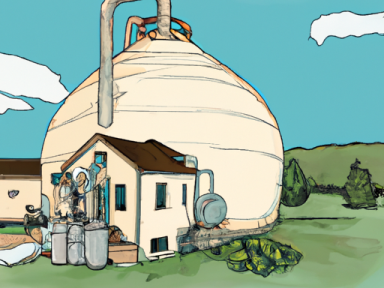
Advanced Methods for Biogas Production and Utilization
When it comes to self-reliance and sustainable living, finding alternative sources of energy is crucial. One such method that has gained significant popularity is the production of biogas from organic waste. Biogas is a renewable energy source that can be used for cooking, heating, and even generating electricity. In this article, we will explore advanced methods for creating and utilizing biogas from organic waste to meet your energy needs.
The Process of Biogas Production
The production of biogas involves the breakdown of organic matter in the absence of oxygen through a process called anaerobic digestion. This process takes place in a specialized system known as a biogas digester. Here’s a step-by-step guide to biogas production:
- Collect Organic Waste: Start by collecting organic waste such as kitchen scraps, agricultural residues, or animal manure. It’s important to use a mixture of different types of waste to ensure a balanced nutrient profile.
- Feedstock Preparation: Shred or chop the organic waste into smaller pieces to increase the surface area for microbial activity and facilitate faster decomposition.
- Load the Digester: Transfer the prepared organic waste into the biogas digester. Ensure that the digester is airtight to maintain anaerobic conditions.
- Controlled Environment: Maintain the optimum temperature and pH level inside the digester for the efficient functioning of the anaerobic bacteria that produce biogas.
- Biogas Production: As the organic waste decomposes, methane and carbon dioxide gases are released. These gases, collectively known as biogas, rise to the top of the digester.
- Gas Storage: Collect and store the biogas in a separate chamber or storage tank. The biogas can be used immediately or stored for future use.
- Utilization: Biogas can be utilized for cooking purposes by connecting the digester to a gas stove or a gas burner. It can also be used for heating water or generating electricity using a biogas generator.
- Residual Material: After the anaerobic digestion process is complete, the residual material, called digestate, can be used as a nutrient-rich organic fertilizer for plants.
The Benefits of Biogas Production
Now that we understand the process of biogas production, let’s explore the benefits it offers:
- Energy Independence: Producing your own biogas allows you to become less reliant on traditional energy sources. In times of crisis or limited resources, having your own source of energy can be invaluable.
- Reduction in Waste: By utilizing organic waste that would otherwise end up in landfills, biogas production contributes to reducing environmental pollution.
- Renewable and Clean Energy: Biogas is a renewable energy source that helps reduce greenhouse gas emissions. It produces fewer pollutants compared to fossil fuels, making it environmentally friendly.
- Cost Savings: Producing biogas can significantly reduce your energy expenses. You can save money on cooking fuel, heating, and electricity bills by utilizing this free source of energy.
- Multiple Applications: Biogas can be used for various purposes, including cooking, heating, generating electricity, and even fueling vehicles with the right equipment.
Advanced Techniques for Optimal Biogas Production
To enhance the efficiency and effectiveness of biogas production, consider implementing these advanced techniques:
- Co-digestion: Combine different types of organic waste to create an ideal blend for biogas production. This increases the nutrient value and improves the biogas yield.
- Temperature Control: Maintain an optimal temperature range inside the digester to facilitate the growth of methane-producing bacteria. Insulation and heat exchangers can assist in maintaining the desired temperature.
- Continuous Stirring: Regularly mixing the organic waste inside the digester promotes better decomposition and prevents the formation of scum or floating layers.
- Gas Purification: Install a gas purification system to remove impurities such as hydrogen sulfide and moisture from the biogas, ensuring cleaner and safer usage.
- Efficient Gas Storage: Use gas storage systems that minimize gas leaks and maintain the quality of stored biogas for longer periods.
Take Action for a Sustainable Future
Now that you have gained insight into the advanced methods of biogas production and utilization, it’s time to take action. By implementing these techniques, you can become more self-reliant, reduce waste, and contribute to a sustainable future. Begin by collecting organic waste and experimenting with small-scale biogas production. Embrace the potential of biogas as a renewable energy source and enjoy the benefits it brings to your homestead and survival preparedness.



GIPHY App Key not set. Please check settings